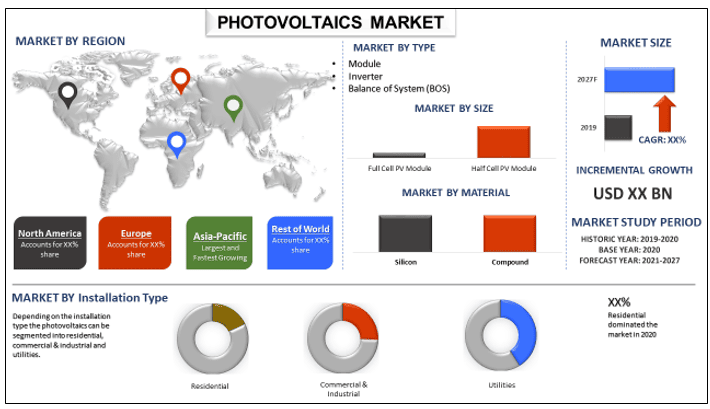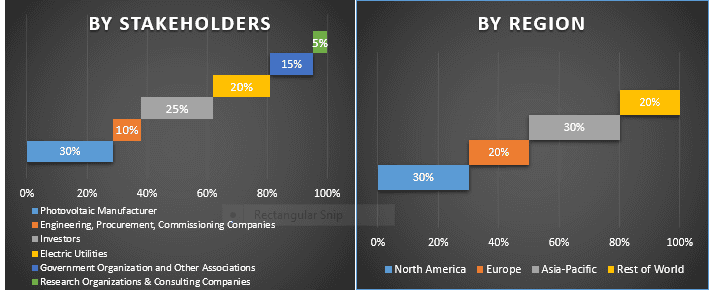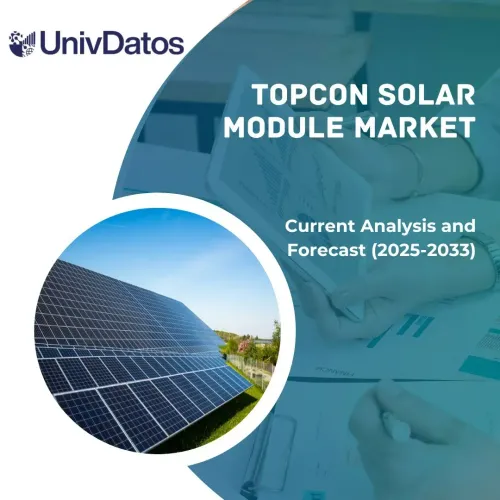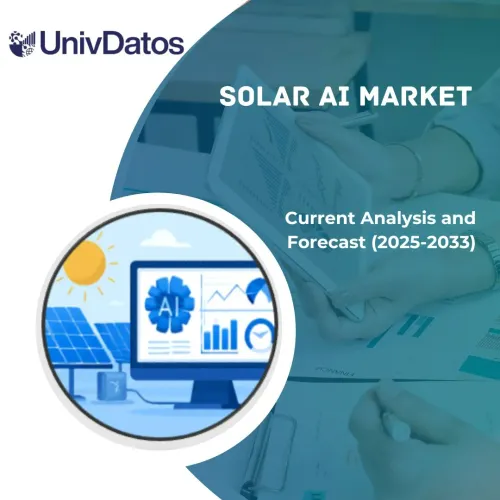- Accueil
- À propos de nous
- Industrie
- Services
- Lecture
- Contactez-nous
Marché photovoltaïque : Analyse actuelle et prévisions (2021-2027)
Accent mis sur le type (Module, Onduleur, Équilibre du système (BOS)) ; Matériau (Composé de silicium) ; Type de cellule (Modules PV à cellule entière, Modules PV à demi-cellule) ; Type d'installation (Résidentiel, Commercial et industriel, Utilités) ; Région/Pays

Le marché mondial du photovoltaïque était évalué à 76,6 milliards de dollars US en 2020 et devrait atteindre 222,5 milliards de dollars US d'ici 2027, affichant un TCAC élevé de 17,2 % sur la période de prévision (2021-2027).
L'énergie photovoltaïque est produite par le rayonnement solaire, et elle peut être convertie en électricité à l'aide de cellules photovoltaïques. Cette électricité peut être utilisée pour alimenter des appareils électriques. En fonction de l'application, le photovoltaïque peut être utilisé comme lampadaire solaire, parcmètres, téléphones d'urgence, compacteurs à ordures, panneaux de signalisation temporaires, bornes de recharge dans les applications commerciales. De même, dans le secteur agricole, la technologie photovoltaïque est utilisée pour générer de l'électricité pour faire fonctionner des pompes à eau à moindre coût et, avec l'utilisation croissante de la technologie photovoltaïque, il est prévu d'accélérer sa part de marché au cours de la période de prévision. De plus, la demande croissante d'électricité dans le monde entier en raison de l'augmentation du nombre d'habitants, associée au besoin croissant d'adopter des sources d'énergie renouvelables durables, sont les facteurs qui alimentent la taille du marché mondial du photovoltaïque. En outre, les politiques et réglementations gouvernementales favorables à la réduction de l'empreinte carbone et à la production d'énergie à faible coût sont également les principaux facteurs qui alimentent la demande du marché photovoltaïque.
Évolution mondiale de la demande d'électricité en 2020 et 2021 par région (%)
Pendant la pandémie de Covid-19 au début de 2020, la majorité des pays et des régions ont été témoins d'un confinement à l'échelle nationale. Le confinement imposé dans diverses régions a entraîné la fermeture complète des installations de fabrication afin de réduire la propagation du Covid-19, ce qui a gravement perturbé la chaîne d'approvisionnement. Cela a également eu un impact sur la fabrication de photovoltaïques en Chine, ce qui a un impact direct sur la demande du marché photovoltaïque indien. Cependant, la part de marché du photovoltaïque devrait se redresser après 2020. Cela est dû à l'adoption croissante de l'énergie renouvelable en raison de la préoccupation croissante de protéger l'environnement contre les émissions dangereuses. En outre, les politiques gouvernementales favorables stimulent la croissance du marché.
Aperçus présentés dans le rapport
« Parmi les types, le segment des onduleurs a dominé le marché en 2020. »
En fonction du type, le marché mondial du photovoltaïque est segmenté en modules, onduleurs et équilibre du système (BOS). Actuellement, le segment des onduleurs domine le marché. Car l'onduleur solaire peut convertir le courant continu en courant alternatif, ce qui est alors efficace pour une application résidentielle. De plus, les progrès croissants de la technologie des onduleurs solaires contribuent à améliorer son niveau de performance et, avec l'adoption croissante du photovoltaïque en toiture, la demande d'onduleurs solaires augmente également, ce qui, à son tour, accélérerait également la part de marché des onduleurs au cours de la période de prévision.
« Parmi les matériaux, le segment du silicium a dominé le marché en 2020. »
En fonction du matériau, le marché est divisé en silicium et en composé. Le segment du silicium domine le marché. Le matériau photovoltaïque en silicium devrait connaître une croissance rapide en raison des avantages des cellules solaires en silicium cristallin qui augmentent l'efficacité et réduisent le coût de l'installation finale du photovoltaïque, car quelques cellules solaires doivent être installées pour obtenir le rendement souhaité.
« Parmi les types de cellules, le segment des modules PV à cellule entière a dominé le marché en 2020. »
En fonction du type de cellule, le marché est divisé en modules PV à cellule entière et en modules PV à demi-cellule. Actuellement, le segment des modules PV à cellule entière domine le marché, cependant, le segment des modules PV à demi-cellule devrait connaître une forte demande au cours de la période de prévision.
« Parmi les types d'installation, le segment résidentiel a dominé le marché en 2020. »
En fonction du type d'installation, le marché est segmenté en résidentiel, commercial et industriel et services publics. Le segment résidentiel détient une part importante, tandis que les services publics ont également une présence considérable sur le marché
« L'Asie-Pacifique représente les plus grands marchés du marché mondial du photovoltaïque. »
Pour une meilleure compréhension de l'adoption du marché, le rapport fournit une analyse détaillée pour les principales régions et pays, notamment l'Amérique du Nord (États-Unis, Canada, Reste de l'Amérique du Nord), l'Europe (Allemagne, Royaume-Uni, France, Espagne, Reste de l'Europe), l'Asie-Pacifique (Chine, Japon, Inde, Australie, Reste de l'APAC) et le Reste du monde. L'Asie-Pacifique a dominé le marché en raison de l'adoption croissante des modules PV dans des pays tels que la Chine, le Japon et l'Inde. Certaines des principales entreprises profilées dans le rapport incluent Canadian Solar, Hanwha Q CELLS, Trina Solar Limited, Jinko Solar Holding, GCL System Integration, JA Solar Holdings, Shunfeng International Clean Energy Limited, Sharp Corporation, Risen Energy, Mitsubishi Electric Corporation, Suntech Power.
Raisons d'acheter ce rapport :
- L'étude comprend une analyse de la dimension du marché et des prévisions validée par des experts clés du secteur authentifiés
- Le rapport présente un aperçu rapide de la performance globale de l'industrie en un coup d'œil
- Le rapport couvre une analyse approfondie des principaux acteurs du secteur, en mettant l'accent sur les principales données financières des entreprises, le portefeuille de produits, les stratégies d'expansion et les développements récents
- Examen détaillé des moteurs, des contraintes, des principales tendances et des opportunités prévalant dans l'industrie
- L'étude couvre de manière exhaustive le marché dans différents segments
- Analyse approfondie de l'industrie au niveau des pays
Options de personnalisation :
Le marché mondial du photovoltaïque peut être personnalisé en fonction des exigences ou de tout autre segment de marché. En outre, UMI comprend que vous pouvez avoir vos propres besoins commerciaux, n'hésitez donc pas à nous contacter pour obtenir un rapport qui correspond parfaitement à vos exigences.
Table des matières
Analyse du marché historique, estimation du marché actuel et prévision du marché futur du photovoltaïque. Les trois principales étapes entreprises pour créer et analyser son adoption dans le monde entier. Des recherches secondaires exhaustives ont été menées pour collecter les chiffres historiques du marché et estimer la taille actuelle du marché. Deuxièmement, pour valider ces informations, de nombreuses conclusions et hypothèses ont été prises en considération. De plus, des entretiens primaires exhaustifs ont également été menés, avec des experts de l'industrie tout au long de la chaîne de valeur de l'industrie photovoltaïque. Après l'hypothèse et la validation des chiffres du marché par le biais d'entretiens primaires, nous avons employé une approche ascendante pour prévoir la taille complète du marché. Par la suite, des méthodes de ventilation du marché et de triangulation des données ont été adoptées pour estimer et analyser la taille du marché des segments et des sous-segments auxquels l'industrie appartient. La méthodologie détaillée est expliquée ci-dessous :
Analyse de la taille historique du marché
Étape 1 : Étude approfondie des sources secondaires :
Une étude secondaire détaillée a été menée pour obtenir la taille historique du marché du marché photovoltaïque par le biais de sources internes de l'entreprise telles querapports annuels et états financiers, présentations de performance, communiqués de presse, etc.et des sources externes, notammentrevues, actualités et articles, publications gouvernementales, publications de concurrents, rapports sectoriels, bases de données tierces et autres publications crédibles.
Étape 2 : Segmentation du marché :
Après avoir obtenu la taille historique du marché du marché photovoltaïque, nous avons mené une analyse secondaire détaillée pour recueillir des informations et des parts de marché actuelles pour différents segments et sous-segments des principales régions. Les principaux segments inclus dans le rapport sont par type, matériau, type de cellule, type d'installation, type de déploiement, technologie. D'autres analyses régionales et au niveau des pays ont été menées pour évaluer l'adoption globale du photovoltaïque dans le monde.
Étape 3 : Analyse des facteurs :
Après avoir acquis la taille historique du marché des différents segments et sous-segments, nous avons mené une analyse détailléeanalyse des facteurspour estimer la taille actuelle du marché du photovoltaïque. De plus, nous avons mené une analyse factorielle en utilisant des variables dépendantes et indépendantes telles que la croissance du secteur industriel, la demande croissante d'électricité en raison de la croissance de la population urbaine, etc. Une analyse approfondie a été menée pour le scénario de l'offre et de la demande en tenant compte des principaux partenariats, des fusions et acquisitions, de l'expansion des activités et des lancements de produits dans l'industrie photovoltaïque.
Estimation et prévision de la taille actuelle du marché
Dimensionnement actuel du marché :Sur la base des informations exploitables issues des 3 étapes ci-dessus, nous sommes arrivés à la taille actuelle du marché, aux principaux acteurs du marché mondial du photovoltaïque et aux parts de marché de chaque segment. Toutes les parts en pourcentage requises, les répartitions et les ventilations du marché ont été déterminées en utilisant l'approche secondaire susmentionnée et ont été vérifiées par le biais d'entretiens primaires.
Estimation et prévision :Pour l'estimation et les prévisions du marché, des pondérations ont été attribuées aux différents facteurs, notamment les moteurs et les tendances, les contraintes et les opportunités disponibles pour les parties prenantes. Après avoir analysé ces facteurs, des techniques de prévision pertinentes, c'est-à-dire une approche ascendante, ont été appliquées pour parvenir aux prévisions du marché jusqu'en 2027 pour les différents segments et sous-segments dans les principales régions du monde. La méthodologie de recherche adoptée pour estimer la taille du marché englobe :
- La taille du marché de l'industrie, en termes de valeur (USD) et le taux d'adoption du photovoltaïque sur les principaux marchés
- Toutes les parts en pourcentage, les répartitions et les ventilations des segments et sous-segments de marché
- Principaux acteurs du marché photovoltaïque en termes de services offerts. De même, les stratégies de croissance adoptées par ces acteurs pour être compétitifs sur le marché en croissance rapide.
Validation de la taille et de la part de marché
Recherche primaire :Des entretiens approfondis ont été menés avec les principaux leaders d'opinion (KOL), notamment les cadres de haut niveau (CXO/VP, responsables des ventes, responsables du marketing, responsables opérationnels et responsables régionaux, chefs de pays, etc.) dans les principales régions. Les résultats de la recherche primaire ont ensuite été résumés et une analyse statistique a été effectuée pour prouver l'hypothèse énoncée. Les données issues de la recherche primaire ont été consolidées avec les conclusions secondaires, transformant ainsi l'information en informations exploitables.
Répartition des principaux participants dans différentes régions

Ingénierie de marché
La technique de triangulation des données a été employée pour compléter l'estimation globale du marché et pour obtenir des chiffres statistiques précis de chaque segment et sous-segment du marché photovoltaïque mondial. Les données ont été divisées en plusieurs segments et sous-segments après avoir étudié divers paramètres et tendances dans les domaines du type, du matériau, du type de cellule, du type d'installation, du type de déploiement et de la technologie.
L'objectif principal de l'étude de marché photovoltaïque
Les tendances actuelles et futures du marché photovoltaïque mondial ont été identifiées dans l'étude. Les investisseurs peuvent obtenir des informations stratégiques pour fonder leurs décisions d'investissement à partir de l'analyse qualitative et quantitative réalisée dans l'étude. Les tendances actuelles et futures du marché détermineraient l'attractivité globale du marché au niveau national, offrant une plateforme aux acteurs industriels pour exploiter le marché inexploité et bénéficier d'un avantage de premier arrivé. D'autres objectifs quantitatifs des études incluent :
- Analyser la taille actuelle et prévue du marché photovoltaïque en termes de valeur (USD). De plus, analyser la taille actuelle et prévue du marché des différents segments et sous-segments
- Les segments de l'étude comprennent les domaines du type, du type de matériau, du type de cellule, du type d'installation, du type de déploiement et de la technologie
- Analyse définie du cadre réglementaire de l'industrie photovoltaïque
- Analyser la chaîne de valeur impliquée avec la présence de divers intermédiaires, ainsi qu'analyser les comportements des clients et des concurrents de l'industrie
- Analyser la taille actuelle et prévue du marché du photovoltaïque pour les principaux pays
- Les principales régions/pays analysés dans le rapport comprennent l'Amérique du Nord (États-Unis, Canada, Reste de l'Amérique du Nord), l'Europe (Allemagne, Royaume-Uni, France, Espagne, Reste de l'Europe), l'Asie-Pacifique (Chine, Japon, Inde, Australie, Reste de l'Asie-Pacifique) et le Reste du monde
- Profils des entreprises des acteurs du marché photovoltaïque et stratégies de croissance adoptées par ceux-ci pour se maintenir sur un marché en forte croissance
- Analyse approfondie de l'industrie au niveau national
Connexes Rapports
Les clients qui ont acheté cet article ont également acheté










